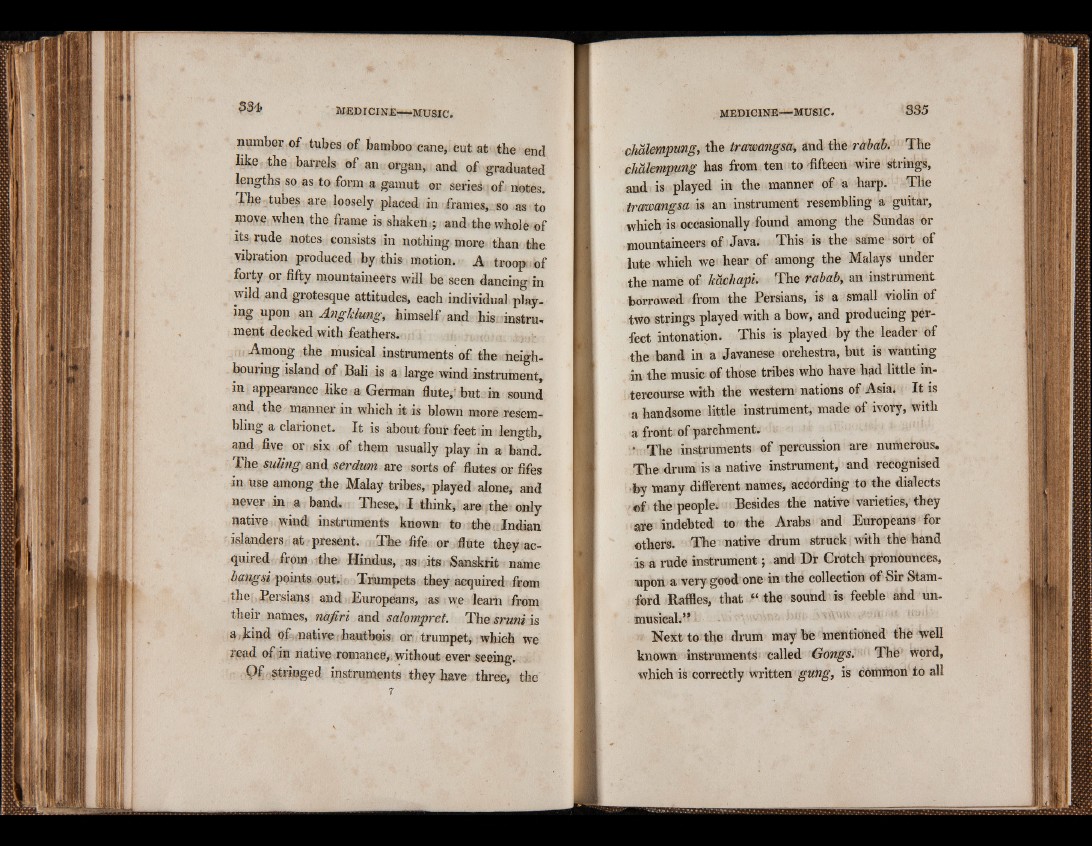
number of tubes of bamboo cane, cut at the end
like the barrels of an organ, and of graduated
lengths so as to form a gamut or series of notes.
The tubes are loosely placed in frames, so as to
move when the frame is shaken;; and the whole of
its rude notes consists in nothing more than the
vibration produced by this motion. A troop of
forty or fifty mountaineers will be seen dancing in
wild and grotesque attitudes, each individual playing
upon an Angklung, himself and his instru.
ment decked with feathers.
Among the musical instruments of the neighbouring
island of Bali is a large wind instrument,
in appearance like a German fluted but : in sound
and the manner in which it is blown more resembling
a clarionet. It is about- four feet in length,
and five or six of them usually play in a band.
The suling and serdum are sorts of flutes or fifes
in use among the Malay tribes, played alone, and
never in a band. These, I think, are .the only
native wind instruments known to the Indian
islanders, at present. The fife or flute they acquired
from the Hindus, as its Sanskrit name
bang si points out. Trumpets they acquired from
the: Persians and Europeans, as we learn from
theft names, naftvi and salompvct. The svuni is
a,¿kind of native hautbois or trumpet, which we
read of in native romance, without ever seeing.
Of stringed instruments they have three, the
chalempmg, the trawangsa, and the rabab. The
chdlempung has from ten to fifteen wire strings,
and is played in the manner of a harp. Tlie
trawangsa is an instrument resembling a guitar,
w h i c h is occasionally found among the Sundas or
mountaineers of Java. This is the same sort of
lute which we hear of among the Malays under
the name of kachapi. The vabab, an instrument
borrowed from the Persians, is a small violin of
two strings played with a bow, and producing perfect
intonation. This is played by the leader of
the band in a Javanese orchestra, but is wanting
in the music of those tribes who have had little intercourse
with the western nations of Asia. It is
a handsome little instrument, made of ivory, with
a front of parchment.
* The instruments of percussion are numerous.
The drum is a native instrument, and recognised
by many different names, according to the dialects
of the people* Besides the native varieties, they
are indebted to the Arabs and Europeans for
others. The native drum struck with the hand
is a rude instrument; and Dr Crotch pronounces,
upon a very good one in the collection of Sir Stamford
Raffles, that “ the sound is feeble and unmusical.’
1
Next to the drum may be mentioned the well
known instruments called Gongs. The word,
which is correctly written guftg, is common to all